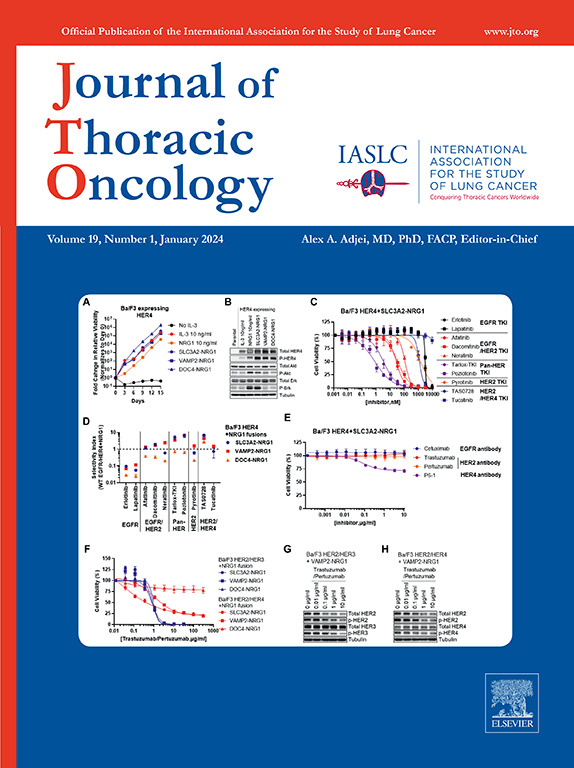The International Association for the Study of Lung Cancer Staging Project: The Database and Proposal for the Revision of the Staging of Pulmonary Neuroendocrine Carcinoma in the Forthcoming Ninth Edition of the TNM Classification for Lung Cancer
IF 21
1区 医学
Q1 ONCOLOGY
引用次数: 0
Abstract
Introduction
Pulmonary high-grade neuroendocrine carcinoma (NEC) includes SCLC and large cell NEC (LCNEC). The seventh and eighth editions of the TNM classification for lung cancer confirmed the applicability of this staging system for SCLC. With the proposal of N2 and M1c subcategories for the ninth edition classification, we assessed the applicability to NECs.
Methods
The database included NEC cases diagnosed between January 2011 and December 2019. Eligible cases, with valid survival time and eighth edition TNM stage, were classified as pure SCLC, combined SCLC with NSCLC, and LCNEC. Survival was calculated using the Kaplan-Meier method, pairwise differences using a log-rank test, and prognostic groups using a Cox regression analysis.
Results
There were 6181 pure and combined SCLC and 697 LCNEC cases available. For SCLC, survival outcome analyses included 4453 cases with clinical stage and 583 with pathologic stage data. The corresponding numbers for LCNEC were 585 and 508. The SCLC data validated the ninth edition classification for lung cancer, including the proposed new subcategories, N2a, single-station ipsilateral mediastinal or subcarinal lymph node involvement, and N2b, involvement of multiple ipsilateral or subcarinal stations. The data also validated the subcategorization of M1c into M1c1 (multiple lesions in a single extrathoracic organ system) and M1c2 (involvement of multiple extrathoracic organ systems). The LCNEC data were insufficient for complete survival analysis, but the available data reported decreasing survival with increasing clinical and pathologic stages.
Conclusions
The ninth edition TNM classification applies to patients with NEC and is the appropriate standard for use in clinical practice.

国际肺癌分期研究协会项目:即将出版的第9版肺癌TNM分类中肺神经内分泌癌分期的数据库和修订建议。
肺高级神经内分泌癌(NEC)包括小细胞肺癌(SCLC)和大细胞神经内分泌癌(LCNEC)。肺癌TNM分级的第七版和第八版证实了该分级系统对SCLC的适用性。随着第九版分类中N2和M1c子类别的提出,我们评估了nec的适用性。方法:数据库纳入2011年1月至2019年12月诊断的NEC病例。符合条件的病例,具有有效生存时间和第八版TNM分期,分为单纯SCLC、SCLC/非小细胞癌合并和LCNEC。生存率采用Kaplan-Meier法计算,两两差异采用log-rank检验,预后组采用Cox回归分析。结果:6181例单纯/合并SCLC和697例LCNEC。对于SCLC,生存结果分析包括4453例临床分期和583例病理分期数据。LCNEC对应的数字是585和508。SCLC数据验证了第九版肺癌分类,包括提出的新亚类,N2a,单侧纵隔/隆突下淋巴结受累,N2b,多侧/隆突下淋巴结受累。数据还验证了M1c亚分类为M1c1(单个胸外器官系统多发病变)和M1c2(多个胸外器官系统受累)。LCNEC的数据不足以进行完整的生存分析,但现有数据显示,随着临床和病理分期的增加,生存率降低。结论:第九版TNM分类适用于NEC患者,是临床应用的合适标准。
本文章由计算机程序翻译,如有差异,请以英文原文为准。
求助全文
约1分钟内获得全文
求助全文
来源期刊

Journal of Thoracic Oncology
医学-呼吸系统
CiteScore
36.00
自引率
3.90%
发文量
1406
审稿时长
13 days
期刊介绍:
Journal of Thoracic Oncology (JTO), the official journal of the International Association for the Study of Lung Cancer,is the primary educational and informational publication for topics relevant to the prevention, detection, diagnosis, and treatment of all thoracic malignancies.The readship includes epidemiologists, medical oncologists, radiation oncologists, thoracic surgeons, pulmonologists, radiologists, pathologists, nuclear medicine physicians, and research scientists with a special interest in thoracic oncology.
 求助内容:
求助内容: 应助结果提醒方式:
应助结果提醒方式:


